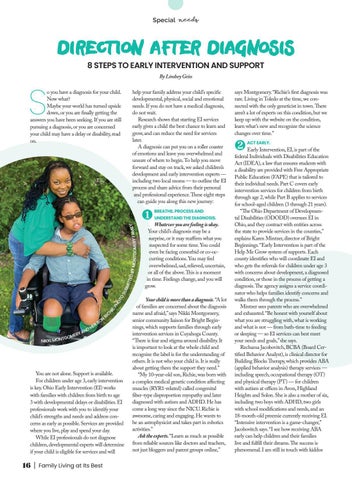Special NEEDS
Direction After Diagnosis 8 STEPS TO EARLY INTERVENTION AND SUPPORT By Lindsey Geiss
S
o you have a diagnosis for your child. Now what? Maybe your world has turned upside down, or you are finally getting the answers you have been seeking. If you are still pursuing a diagnosis, or you are concerned your child may have a delay or disability, read on.
help your family address your child’s specific developmental, physical, social and emotional needs. If you do not have a medical diagnosis, do not wait. Research shows that starting EI services early gives a child the best chance to learn and grow, and can reduce the need for services later. A diagnosis can put you on a roller coaster of emotions and leave you overwhelmed and unsure of where to begin. To help you move forward and stay on track, we asked children’s development and early intervention experts — including two local moms — to outline the EI process and share advice from their personal and professional experience. These eight steps can guide you along this new journey:
HI E. PH OT O
SU BM ITTE D
BY MO ILY NTGOMERY FAM
❶
ND YA MER O G T NIKKI MON
ON RS HE
C RI
You are not alone. Support is available. For children under age 3, early intervention is key. Ohio Early Intervention (EI) works with families with children from birth to age 3 with developmental delays or disabilities. EI professionals work with you to identify your child’s strengths and needs and address concerns as early as possible. Services are provided where you live, play and spend your day. While EI professionals do not diagnose children, developmental experts will determine if your child is eligible for services and will
16 | Family Living at Its Best
BREATHE. PROCESS AND
UNDERSTAND THE DIAGNOSIS.
Whatever you are feeling is okay. Your child’s diagnosis may be a surprise, or it may reaffirm what you suspected for some time. You could even be facing comorbid or co-occurring conditions. You may feel overwhelmed, sad, relieved, uncertain, or all of the above. This is a moment in time. Feelings change, and you will grow.
Your child is more than a diagnosis. “A lot of families are concerned about the diagnosis name and afraid,” says Nikki Montgomery, senior community liaison for Bright Beginnings, which supports families through early intervention services in Cuyahoga County. “There is fear and stigma around disability. It is important to look at the whole child and recognize the label is for the understanding of others. It is not who your child is. It is really about getting them the support they need.” “My 10-year-old son, Richie, was born with a complex medical genetic condition affecting muscles (RYR1-related) called congenital fiber-type disproportion myopathy and later diagnosed with autism and ADHD. He has come a long way since the NICU. Richie is awesome, caring and engaging. He wants to be an astrophysicist and takes part in robotics activities.” Ask the experts. “Learn as much as possible from reliable sources like doctors and teachers, not just bloggers and parent groups online,”
says Montgomery. “Richie’s first diagnosis was rare. Living in Toledo at the time, we connected with the only geneticist in town. There aren’t a lot of experts on this condition, but we keep up with the website on the condition, learn what’s new and recognize the science changes over time.”
❷
ACT EARLY.
Early Intervention, EI, is part of the federal Individuals with Disabilities Education Act (IDEA), a law that ensures students with a disability are provided with Free Appropriate Public Education (FAPE) that is tailored to their individual needs. Part C covers early intervention services for children from birth through age 2, while Part B applies to services for school-aged children (3 through 21 years). “The Ohio Department of Developmental Disabilities (ODODD) oversees EI in Ohio, and they contract with entities across the state to provide services in the counties,” explains Karen Mintzer, director of Bright Beginnings. “Early Intervention is part of the Help Me Grow system of supports. Each county identifies who will coordinate EI and who gets the referrals for children under age 3 with concerns about development, a diagnosed condition, or those in the process of getting a diagnosis. The agency assigns a service coordinator who helps families identify concerns and walks them through the process.” Mintzer sees parents who are overwhelmed and exhausted. “Be honest with yourself about what you are struggling with, what is working and what is not — from bath-time to feeding or sleeping — so EI services can best meet your needs and goals,” she says. Rechama Jacobovitch, BCBA (Board Certified Behavior Analyst), is clinical director for Building Blocks Therapy, which provides ABA (applied behavior analysis) therapy services — including speech, occupational therapy (OT) and physical therapy (PT) — for children with autism at offices in Avon, Highland Heights and Solon. She is also a mother of six, including two boys with ADHD, two girls with school modifications and needs, and an 18-month-old preemie currently receiving EI. “Intensive intervention is a game-changer,” Jacobovitch says. “I see how receiving ABA early can help children and their families live and fulfill their dreams. The success is phenomenal. I am still in touch with kiddos
